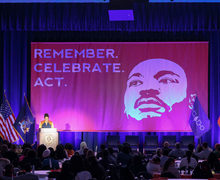SU professor Lawrence Chua discusses his book ‘Bangkok Utopia’
Screenshot
Chua, an associate professor at SU's School of Architecture, discussed his research on 20th century architecture in Bangkok with Anoma Pieris.
Get the latest Syracuse news delivered right to your inbox.
Subscribe to our newsletter here.
UPDATED: Jan. 26, 2022 at 12:57 p.m.
Lawrence Chua started searching archives and compiling information for his book “Bangkok Utopia” in 2014, but he said it feels like it’s been forever.
“The book’s genesis maybe really begins like 200 years ago at Cornell,” Chua joked.
On Tuesday night, Lawrence Chua discussed his 2021 book, “Bangkok Utopia,” with Anoma Pieris and 68 other virtual attendees on Zoom. The book examines how the contemporary architecture of Bangkok in the 20th century reconciled utopian desires and Buddhist liberation.
Chua, an associate professor of architectural history at Syracuse University, said he wanted to begin his research when he heard that Thailand was the only Southeast Asian country that had never been colonized by Europe.
“I was really interested in putting that to the test and seeing whether that was true or not,” he said.
While researching for his book, Chua said he utilized archives in Thailand, as well as smaller archives in places like Germany that were disorganized and hard to access at times.
“These archives were really rich,” he said. “There was one floor that was sealed and took months to get permission to enter.”
Rather than just discussing the effects of European and American colonization in neighboring Asian countries like Japan, he used them as context to discuss Thailand’s Buddhist felicities, like nirvana, through architecture. Chua said the book utilizes the lens of utopia that the countries are associated with to examine the impact the materials used and buildings constructed had on Thailand.
In addition to its chronological organization, the book is divided into three parts: tools, materials and urban planning during the Cold War, Chua said.
The first section on tools delves into how certain ideas are given representative forms through things like models and diagrams. This part of the book discusses how Thailand experiences its first true encounter with democracy over the course of three years.
Real books smell amazing. @UHPRESSNEWS pic.twitter.com/7WYXFoWCN8
— Dr. Lawrence Chua ดร. ลิขิต ฉั่ว លរេនស័ ឈួះ 蔡明亮 (@lc288chua) February 15, 2021
The second part of the book addresses materials and how those ideas are transformed into constructed works. The third part is a single, large chapter which covers how urban planning during the Cold War created a larger neo-liberal system in Bangkok.
“I structured the book to follow the trajectory of an idea through to a built work and then look at how those built works are integrated into larger urban systems,” he said.
Chua also structured his book through genealogy, he said. While it’s not the definition of genealogy that philosophers in the past have coined, the book’s definition is based on tying together the people of Bangkok with the images that they made and their varying perceptions of the same ideas at different times.
“I’m not sure I’m using genealogy in a way that Foucault or Nietzsche would approve,” Chua said.
He said that the material that held the most impact in Thailand’s 20th century architecture was steel-reinforced concrete. It was used to construct buildings like the Democracy Monument, which was built after the Thai — formerly Siamese — people overthrew the monarchy. In the apex, the constitution lays on a gold offering tray.
Through his research, Chua found that despite new buildings and architectural discoveries under their rule, such as the introduction of air conditioning to contradict the “dirtiness” of Thailand, the government that replaced the monarchy was ultimately a military dictatorship that went against the values symbolized in structures like the Democracy Monument.
“There’s no better symbol of the contradictions in Thai society than this,” he said. “These images were what a better modern world would look like.”
After the discussion hosted by Pieris ended, the floor was opened to people in the audience to ask questions.
When asked what the most surprising thing he discovered through his research was, Chua took a pause that lasted about 10 seconds before he came to an answer.
“It’s how little things have changed,” he said. “It’s how much the past resembles the moment that we inhabit today.”
CORRECTION: A previous version of this post misquoted Chua by saying “nature” instead of “Nietzsche.” The Daily Orange regrets this error.
Published on January 26, 2022 at 12:22 am
Contact Siron: sthoma10@syr.edu | @sironthomas






